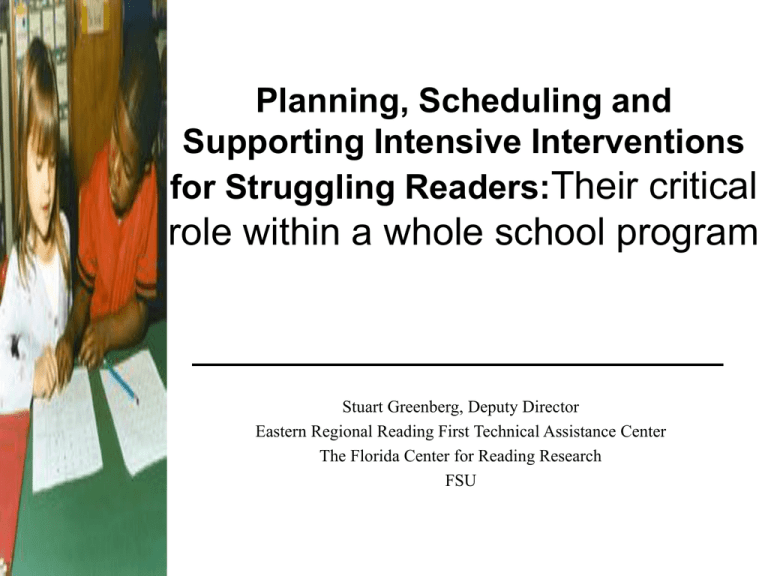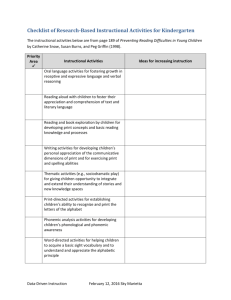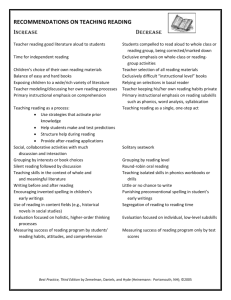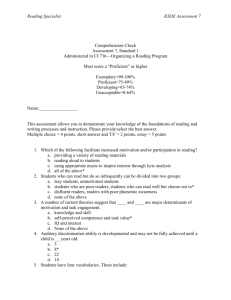Downloadable PowerPoint - Florida Center for Reading Research
advertisement

Planning, Scheduling and Supporting Intensive Interventions for Struggling Readers:Their critical role within a whole school program Stuart Greenberg, Deputy Director Eastern Regional Reading First Technical Assistance Center The Florida Center for Reading Research FSU A Special Thank You The ERRFTAC Team, Joe Torgesen, Pat Howard, Marcia Grek, Edward Kame'enui,The FCRR staff, The NRFTAC staff, and all of the great educators in this room and throughout the United States. Teaching Reading is Urgent “No time is as precious or as fleeting as the first years of formal schooling. Research consistently shows that children who get off to a good start in reading rarely stumble. Those who fall behind tend to stay behind for the rest of their academic lives.” (Burns, Griffin, & Snow, 1999, p. 61) Teaching Reading is Urgent Children must be given the opportunity and the support to become successful readers by third grade. Learning to Read Reading to Learn Transitioning Educational Timeline PreK K 1 2 3 4 5 6 7 Infinity Reading First’s model for preventing reading failure in grades K-3: Three big ideas 1. Increase the quality and consistency of instruction in every K-3 classroom. Provide initial instruction that is appropriate to the needs of the majority of students in the class 2. Conduct timely and valid assessments of reading growth to identify struggling readers 3. Provide high quality, intensive interventions to help struggling readers catch up with their peers How Do I Teach the BIG IDEAS in Beginning Reading? "Teaching Reading is Rocket Science.“ Moats, 1999 The Problem and Context: •20% of students have significant reading problems. •Most reading failure is unnecessary. •Teaching Reading is a job for an expert. The Scope of the Reading Problem in America •"17.5 percent of the nation's children--about 10 million children--will encounter reading problems in the crucial first three years of their schooling" (National Reading Panel Progress Report, 2000; •Approximately 75% of students identified with reading problems in the third grade are still reading disabled in the 9th grade. (Shaywitz, et al., 1993; Francis et al., 1996; •Juel found the probability of being a poor reader in fourth grade given you were a poor reader in first grade was 88%. The Solution to the Problem: Quality Initial Instruction and Immediate Intensive Intervention •Identify early and intervene strategically. •Focus on the vital signs. •Teach "less" more thoroughly. •Hold instructional time sacred. •Expect and plan for "different" levels of instruction (e.g., small groups, double dose). •Monitor progress to determine if children are learning enough. Three Organizing Principles for Reading Success 1. Earlier rather than later: Prevention and early intervention are supremely more effective and efficient than later intervention and remediation for ensuring reading success. 2. Schools, not just programs: Prevention and early intervention must be anchored to the school as the host environment and the primary context for improving student reading performance. 3. Evidence, not opinion: Prevention and early intervention pedagogy, programs, and procedures should be based on trustworthy scientific evidence. A Schoolwide Reading Improvement Model 1. What do we know and what guidance can we gain from scientifically based reading research? 2. What outcomes do we want for our students in our state, district, and schools? 3. How are we doing? What is our current level of performance as a school? As a grade? As a class? As an individual student? 4. How far do we need to go to reach our goals and outcomes? 5. What are the critical components that need to be in place to reach our goals? 6. What more do we need to do and what instructional adjustments need to be made? Research indicates that students need to acquire skills and knowledge in at least five main areas in order to become proficient readers Five critical components: Phonemic Awareness Phonics Fluency Vocabulary Comprehension strategies Identifying words accurately and fluently Constructing meaning once words are identified Phonemic Awareness • Research – PA improves word reading, spelling, and comprehension – Poor readers who enter first grade with weak PA are most likely to be the poor readers in fourth grade • Instruction – Auditory Activities – Needs to follow the developmental hierarchy of phonological awareness Phonics Research • “Systematic and explicit phonics instruction is more effective than nonsystematic or no phonics instruction” (Put Reading First, p. 13). • “Systematic and explicit phonics instruction significantly improves children’s reading comprehension” (Put Reading First, p. 14). Fluency Research • “Repeated and monitored oral reading improves reading fluency and overall reading achievement” (Put Reading First, p. 24). Fluency Instruction • Articulate the importance & provide modeling • Reading Levels • Monitor fluency progress • Oral reading with feedback • Variety of research based strategies – Repeated Readings, Timed, Partner Vocabulary Research & Instruction • Can be developed – directly (teach important, difficult, and useful words) – indirectly • Teach word learning strategies – How to use dictionaries and reference aids – How to use word parts to determine meaning of words – How to use context clues to determine meaning • Provide multiple exposures to words • Read aloud to students • Encourage independent wide reading Comprehension Research • “Text comprehension can be improved by instruction that helps readers use specific comprehension strategies.” • “Effective comprehension strategy instruction is explicit, or direct.” Put Reading First, pp. 49, 53 Comprehension Instruction • Monitoring comprehension (promoting metacognition) • Using graphic and semantic organizers – e.g., teaching the use of a Venn diagram to compare and contrast 2 characters from a story • Main Idea • Summarizing • Text Structure Teaching Reading is Urgent • A student in the 20th percentile reads books .7 minutes a day. ______ • This adds up to 21,000 _________words read per year. • A student in the 80th percentile reads books 14.2 minutes a day. ______ • This adds up to 1,146,000 words __________ read per year. WHAT READING DOES FOR THE MIND BY ANNE E.CUNNINGHAM AND KEITH E. STANOVICH.1998 Hart and Risley (1995) conducted a longitudinal study of children and families from three groups: • Professional families • Working-class families • Families on welfare Interactions Hart & Risley compared the mean number of interactions initiated per hour in each of the three groups. 50 40 30 20 10 0 Welfare Working Professional Interactions Hart & Risley also compared the mean number of minutes of interaction per hour in the three groups. 50 40 30 20 10 0 Welfare Working Professional Cumulative Language Experiences Cumulative Words Per Hour 2500 2000 1500 1000 500 0 Welfare Working Professional Cumulative Language Experiences Different words used per hour 500 400 300 200 100 0 Welfare Working Professional Cumulative Language Experiences Cumulative Words Spoken to Child (in millions) 50 40 30 Professional Working 20 Welfare 10 0 0 12 24 Age of child (in months) 36 48 Hart and Risley’s Study • Observed parent-child interaction in 42 families who differed in terms of income • They found: • Children in professional families heard, on average, 2,150 words per hour, whereas children in working class (1,250) and welfare (620) families were exposed to many less words. • The cumulative language experience for children by age 3 differed in amount and kind, and these differences were highly correlated with children’s reading/language performance at ages 9-10. Do the relatively specific instructional program recommendations mean that “one size fits all” approach to instruction? Absolutely Not! How to distinguish different groups of students who failed to meet the standards Current research on student profiles. “Not all poor readers are alike. How do we differentiate for instruction?” (Holly Lane, 2004) •We all know that children vary enormously from one another in their instructional needs. •To be most effective, instruction must be adapted to the needs of individual children. Reading Programs PLUS LEADERSHIP EFFECTIVE INSTRUCTION ASSESSMENT PROFESSIONAL DEVELOPMENT SCIENTIFICALLY BASED READING PROGRAMS The consensus view of most important instructional features for interventions Interventions are more effective when they: Provide systematic and explicit instruction on whatever component skills are deficient: phonemic awareness, phonics, fluency, vocabulary, reading comprehension strategies The logic of instructional intensity Many children are already behind in vocabulary and print knowledge when they enter school. To achieve grade level standards by third grade, poor children must learn vocabulary words at a faster rate than their middle class peers in grades K-3 The most direct way to increase learning rate is by increasing the number of positive, or successful, instructional interactions (pii) per school day. There are a variety of ways to increase the number of positive instructional interactions per school day The consensus view of most important instructional features for interventions Interventions are more effective when they: Provide systematic and explicit instruction on whatever component skills are deficient: phonemic awareness, phonics, fluency, vocabulary, reading comprehension strategies Provide a significant increase in intensity of instruction Provide ample opportunities for guided practice of new skills Provide systematic cueing of appropriate strategies in context Provide appropriate levels of scaffolding as children learn to apply new skills Instructional adaptations for individual children will be made primarily in terms varying amounts and intensity of instruction and practice on the five components If children have difficulties learning “phonics” they should not be switched to a “sight word” approach. This will not build the necessary alphabetic reading skills that are necessary to achieve high levels of reading ability Children who experience reading difficulties must be helped to acquire adequate skills in all five components. If any one of these does not develop properly, the child is unlikely to attain grade level reading skills. •One child may require extra instruction in phonemic awareness and phonics to get a good start in reading •Another child might require extra instruction in vocabulary •Another child may come to school with strong phonemic awareness and letter knowledge, and may require very little instruction in phonics to begin reading to build fluency •Another child may know very little about letters and sounds upon school entry, and may require special instructional support in this area for some time •Still other children will require extended practice to develop reading fluency Who Is At Risk? What Tools Do We Use To Determine Who Is At-Risk Screening + Placement Test + The Results of Science Schedules How can immediate, intensive interventions be scheduled and delivered? 1. Delivered by regular classroom teacher during the “uninterrupted reading period” 2. Delivered by additional resource personnel during the “uninterrupted reading period”, or at other times during day 3. Delivered by classroom and resource personnel during after school or before school programs 4. Delivered by well-trained and supervised paraprofessionals during the “uninterrupted reading period” or other times 5. Delivered by peers during “uninterrupted reading period” 6. Delivered by computers throughout the day How can we insure that interventions are delivered consistently with high quality? Professional development to provide knowledge of instructional strategies, content (scope and sequence and selection of materials), and appropriate practice/skill building activities -- use of assessment data to identify who should receive interventions and what their focus should be Identification of high quality intervention programs/materials and professional development in their use and individualization. What does it take to manage a successful interventions in a RF school? 1. Well trained teachers who understand the process of learning to read and how to identify children lagging behind in development. 2. Systematic and reliable assessments to monitor the growth of critical reading skills 3. Leadership within the school to allocate intervention resources appropriately, and to monitor the use of those resources 4. Appropriate materials available to help structure the interventions and provide instruction and practice activities at the appropriate level of difficulty 5. Personnel to assist the classroom teacher in providing intensive interventions to the students most in need Sample Schedule 8:00 Whole Group Reading 8:30 Group 1 9:00 Group 2 9:30 Group 3 10:00 Flex Group 10:30 Flex Group 11:00 Lunch 11:30 Writing Workshop 12:00 Writing Workshop 12:30 Math 1:00 Math 1:30 PE 2:00 Reading Review Rotations 2:30 Science/Social Studies 3:15 Evaluation/Dismissal Using Data to Schedule Instruction • Establish a process for routinely analyzing data at the student, classroom, grade level, school, and district levels • Think about a few things: • All students receive instruction through the core to the degree that it meets their instructional needs • The iii is taught by the classroom teacher • The iii is taught by a “push-in” teacher • The iii is done through a “ walk and read” model • Share innovative practices with others Tier Tier Tier Tier Tier One Instructional Recommendations Instructional Recommendations Instructional Recomm Benchmark/Low Risk/Established Two Strategic/Some Risk/Emergent Three Intensive/At Risk/ Deficit Instructional Implication Core Reading Core Program + Additional Teaching Core Reading + iii Early Screening Identifies Children Who Need Additional Intervention For example, in one longitudinal study: • 201 randomly selected children from five elementary schools serving children from mixed SES and ethnic backgrounds were followed from the beginning of first grade to the end of fourth grade. • Children who scored low on phonemic awareness and letter knowledge at the beginning of first grade – Started with lower skills – Made less progress – Fell further and further below grade level as they progressed from first through fourth grade. The top five myths about interventions for struggling readers 1. If a child is a “visual” learner, they should be taught to read using a visual, not an auditory strategy 2. If a child has not learned “phonics” by the end of first grade, they need to be taught to read in some other way 3. Children who struggle with phonemic awareness, vocabulary, or phonics in kindergarten and first grade will frequently “catch up” if given time. 4. We should take guidance from theories of “multiple intelligences” or “learning styles” to help us adapt our reading instruction for different children 5. A little quality time with an enthusiastic volunteer tutor can solve most children’s reading problems Early Screening Identifies Children At Risk of Reading Difficulty 5.2 Reading grade level 5 4 3 Low Risk on Early Screening 2 1 At Risk on Early Screening 1 2 3 4 Grade level corresponding to age 2.5 Additional Instructional Intervention Changes Reading Outcomes • Four years later, the researchers went back to the same school. Two major changes were implemented: • First, a research-based comprehensive reading program was implemented for all students, and • Second, children at risk for reading difficulty were randomly assigned to a control group or to a group receiving substantial instructional intervention. Early Intervention Changes Reading Outcomes 5.2 4.9 Reading grade level 5 With substantial instructional intervention 4 3 Low Risk on Early Screening 2 1 At Risk on Early Screening 1 2 3 4 Grade level corresponding to age With research- 3.2 based core but 2.5 without extra instructional intervention Research-Based, Comprehensive Reading Program and Substantial Instructional Intervention Both a research-based comprehensive reading program and substantial instructional intervention were needed for children at risk of reading difficulty. Children receiving substantial additional instructional intervention beyond an effective comprehensive reading program: – Progressed more rapidly than control students, – Had reading skills more like the low risk group than the at risk group, and – Were reading about at grade level. Immediate Intensive Intervention (iii) • iii should be implemented with children as soon as we know, based on assessment data, they are falling behind in the development of critical reading skills. • iii involves children in receiving instruction in reading that is more intensive than what they have been receiving. This can be accomplished by: • reducing the student/teacher ratio • providing more instructional time Both include providing more supports (instructional opportunity, time, resources, materials and/or personnel) Resources to Implement iii 1. Intervention program that accompanies the core reading program 2. Research based program that – targets specific skills, – is implemented explicitly and systematically, – is coordinated and consistent with the work that is being done during initial instruction. http://www.fcrr.org/FCRRreports/reportslist.htm http://oregonreadingfirst.uoregon.edu/ A high-quality intervention program can provide a kind of on-going professional development for teachers in the critical elements and methods of instruction for phonemic awareness, phonics, fluency, vocabulary, and comprehension strategies A Window of Opportunity To every complex problem, there is a simple solution… that doesn’t work that doesn’t work. Mark Twain We know what to do to ensure that virtually every child learns to read early and well. Whether or not we do it will ultimately depend upon how we feel about the fact we haven’t done it so far. We can do this. We have to do this. We have the knowledge. We have the research. Now, we even have the resources. Three Definitions of Schools A series of autonomous classrooms that are connected by a common parking lot. A place where the relatively young watch the relatively old work. A complex organization that is built upon relationships that require individuals to work interdependently. Thank You






